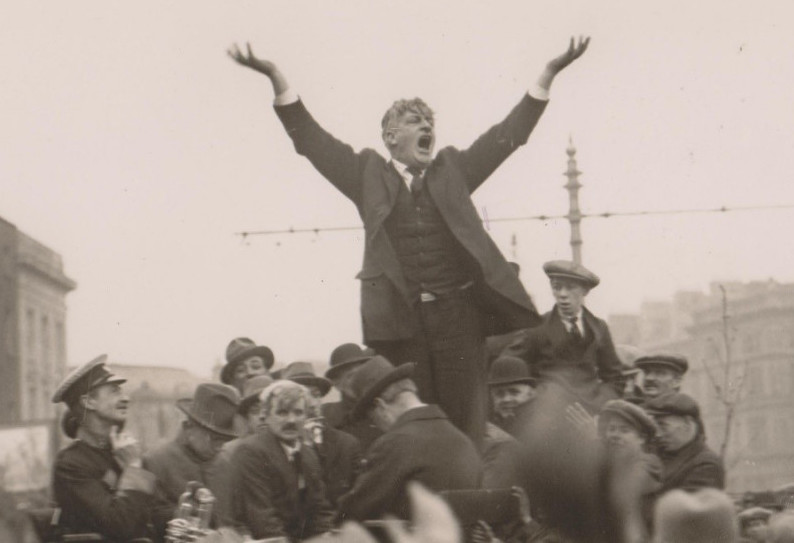Picture the scene: the small backyard of a tiny working-class pub in Belfast at around 8pm on a dark Autumn night. I am smoking with a friend, older by a few years, and with way more life experience, talking about books. A dim-light is ebbing away, further subdued by the frosted glass of the bar-door. He looks at me and says: ‘Strumpet City (James Plunkett‘s 1969 novel) is a good book’. I did not take the time to ask about the work as the conversation was rolling along, covering other novels about Ireland which we had both read, and were reading, or intended to read.
Here were two talking heads, tongues loosened and wagging after a couple of pints. Yet somewhere in the back, ploughed, crow-lifting fields of my sub-conscious, the adjective ‘Strumpet’ and the noun ‘City’ lodged as an unlikely pairing; lighting a candle of intrigue that would burn inside my brain. A decade has sailed past since then.
Cut to a month ago, and I am in my local library with the mad literary hunger on me – the reading hunger. This is where one desires material to satisfy personal taste and preference. For me this is for a well-written and narrated book. And not what I find so demoralising: one that bends down on one knee to the easily accessible, clichéd fountain whose water(s) flow tepidly, and which is, in the beginning, saccharine sweet but gives way to a brackish and unpalatable torpor.
I pick the work up and thumb through its 549 pages. A novel of heft, requiring dedication it seems. I bring it to the desk, and steal away into a showery, sun-lit Wednesday evening with the novel safely stowed inside my bag.
Strumpet City is an historical-led novel which sets out… well… this is a work which, ostensibly, is about the Dublin Lockout(s) of the early twentieth century, narrating fictional, and real, lives of the people involved, including the almost mythological Union leader, Jim Larkin (1874-1947), who James Plunkett previously worked for as his secretary.
This is a novel of coal, ash, and soot. Of wasps amongst blackberries; of hunger and of greed; a novel of slum dwellings and collapsing dockside houses; a work which radiates a stench of unclean bodies and souls, in dire need of cleansing and thorough rituals of purification brought to task.
There is an alcoholic priest who loses his mind due to the drink, whiskey, and on one occasion, topples a coffin off its trestles. It tips over, and the enclosed incumbent resident, due to the lid springing open, falls out, rolling on to the floor. The widowed wife, upon seeing this, screams and two priests soon come over, calm her down and take her away from the morbid scene. The priest, a Father Giffley (memorably played by Cyril Cusack in a memorable 1980 RTE adaptation), is found, soon thereafter, prostrate at the foot of the altar, face-down, unaware of the immoral chaos he has just created and is dozing away.
There is Rashers Tierney, the almost toothless, romantic wanderer who is dirt poor but in the ownership of a rarefied wit and tongue which darts rebuttals in defiance of perceived, and real, attacks; with his mongrel, Rusty, and a penny-whistle in tow. Rashers, as my Belfast friend would have said, ‘Hasn’t a bar in his grate.’
Father O’Connor is the moral authority in the book, a ‘sky pilot’ who turned his back on the riches of a diocese more becoming of his class. He finds his spiritual bedfellow in the form of Mrs. Bradshaw, the face of female humility; in contrast to the encompassing greed of her ideologue, capitalist husband. However, there is an artifice to O’Connor too, which yields a quavering hatred to his position as sitting tenure in the local, disenfranchised, Dublin district which he does acknowledge but does not run away from, which would be the coward’s option. No. He has staying commendable power and you feel for him.
The example of Matt Talbot's piety was used by the Irish Catholic Church in inculcate subservience as the downtrodden were told to await their reward in heaven.https://t.co/8uOS8DgHKe@broadsheet_ie @vincentbrowne @fotoole @connolly16frank @gemmadunleavy1 @AlanGilsenan1
— CassandraVoices (@VoicesCassandra) January 20, 2021
There is a terrible accident at a coal yard and you feel empathy for big Mulhall and the further poverty his family will suffer in its wake.
There are wonderful characters, including Fitz, Hennessy and Mary, set against the backdrop of the 1913 Lockout; striking dockers; the stamping foot(s) of the law and the piercing, shrill whistles of authority. This novel, let me tell you, has a social-economic range, and has it in abundance.
This is not a work to compare to the quotidian, creative deliciousness’ of Joyce’s Ulysses. On this, I have read a good few books, and have many, many more to grapple with, but having read some of Tolstoy, Turgenev, Chekov, and other Russian masters’ creations, this work here, Strumpet City, is, in my view, the Irish equivalent, and a masterpiece.
Feature Image: Jim Larkin




